Financial Decision Making Report: Skanska PLC Analysis, 2018-2019
VerifiedAdded on 2022/11/29
|12
|3570
|180
Report
AI Summary
This report provides a comprehensive analysis of financial decision-making at Skanska PLC, a multinational construction company. It begins with an introduction to the financial decision-making process and its importance for organizational goals. The report then delves into the conceptual framework of the accounting and finance department, outlining the roles and responsibilities of key personnel, such as finance and account managers, and highlighting the importance of effective financial planning, cost management, and compliance with laws and regulations. The report emphasizes the significance of record-keeping, data analysis, and decision-making support provided by the accounting department. The second task involves the evaluation and interpretation of Skanska's financial statements from 2018 to 2019 using various financial ratios, including Return on Capital Employed, Net Profit Margin, Current Ratio, Debtor Collection Period, and Creditor Collection Period. The report provides calculations and interpretations of these ratios to assess Skanska's financial position, business trends, and ability to achieve its financial objectives. Overall, the report underscores the critical role of financial management in supporting Skanska's expansion plans and ensuring its long-term financial health.

FINANCIAL
DECISION MAKING
DECISION MAKING
Secure Best Marks with AI Grader
Need help grading? Try our AI Grader for instant feedback on your assignments.
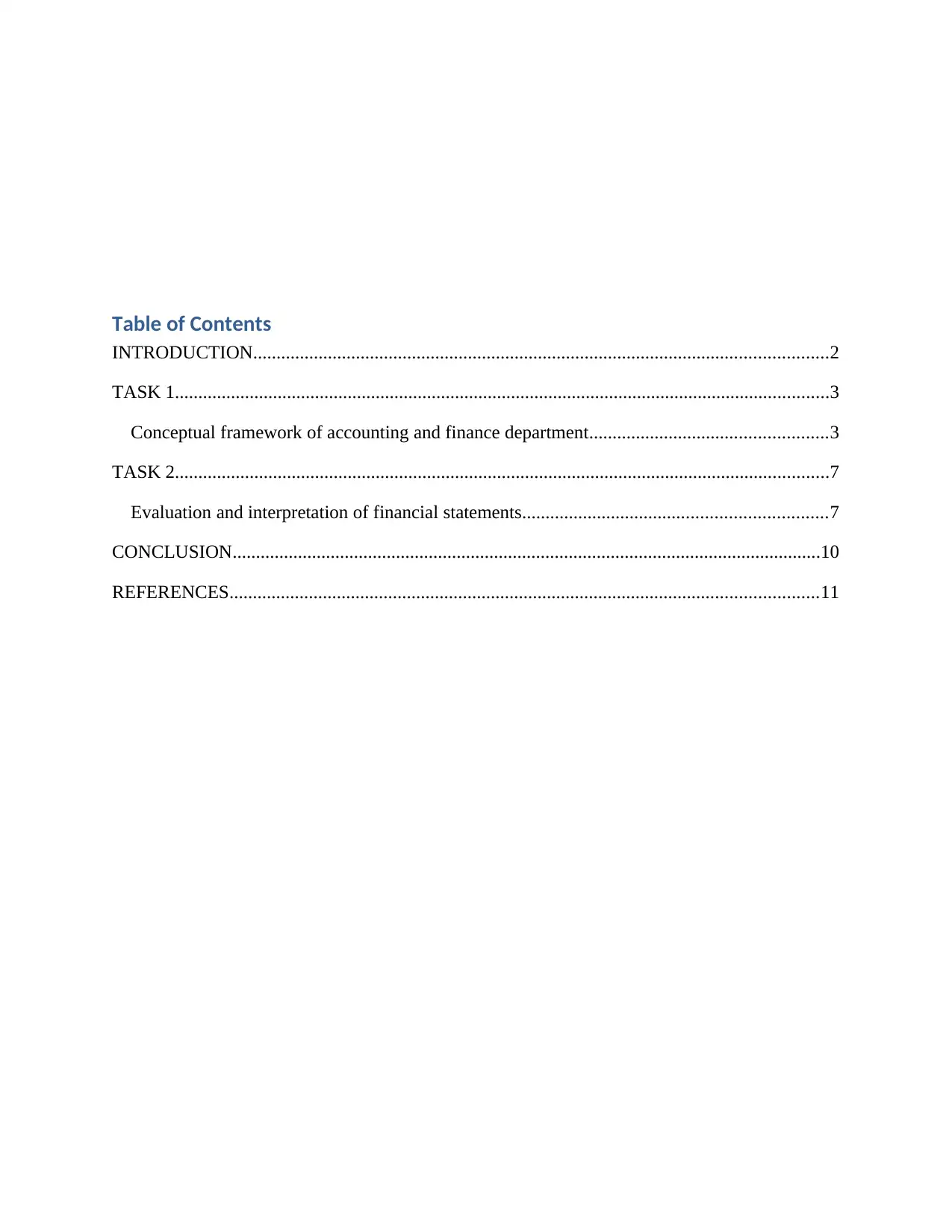
Table of Contents
INTRODUCTION...........................................................................................................................2
TASK 1............................................................................................................................................3
Conceptual framework of accounting and finance department...................................................3
TASK 2............................................................................................................................................7
Evaluation and interpretation of financial statements.................................................................7
CONCLUSION..............................................................................................................................10
REFERENCES..............................................................................................................................11
INTRODUCTION...........................................................................................................................2
TASK 1............................................................................................................................................3
Conceptual framework of accounting and finance department...................................................3
TASK 2............................................................................................................................................7
Evaluation and interpretation of financial statements.................................................................7
CONCLUSION..............................................................................................................................10
REFERENCES..............................................................................................................................11
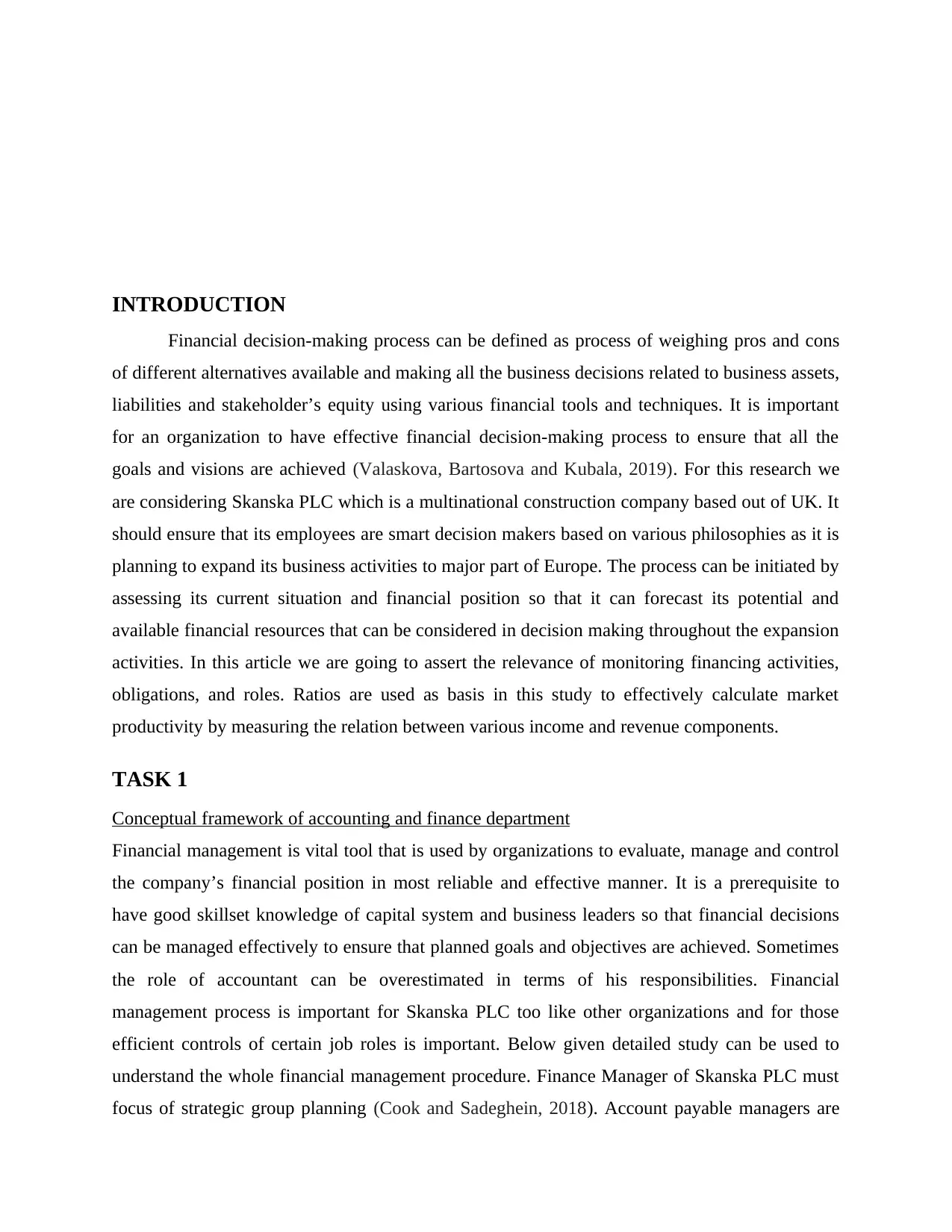
INTRODUCTION
Financial decision-making process can be defined as process of weighing pros and cons
of different alternatives available and making all the business decisions related to business assets,
liabilities and stakeholder’s equity using various financial tools and techniques. It is important
for an organization to have effective financial decision-making process to ensure that all the
goals and visions are achieved (Valaskova, Bartosova and Kubala, 2019). For this research we
are considering Skanska PLC which is a multinational construction company based out of UK. It
should ensure that its employees are smart decision makers based on various philosophies as it is
planning to expand its business activities to major part of Europe. The process can be initiated by
assessing its current situation and financial position so that it can forecast its potential and
available financial resources that can be considered in decision making throughout the expansion
activities. In this article we are going to assert the relevance of monitoring financing activities,
obligations, and roles. Ratios are used as basis in this study to effectively calculate market
productivity by measuring the relation between various income and revenue components.
TASK 1
Conceptual framework of accounting and finance department
Financial management is vital tool that is used by organizations to evaluate, manage and control
the company’s financial position in most reliable and effective manner. It is a prerequisite to
have good skillset knowledge of capital system and business leaders so that financial decisions
can be managed effectively to ensure that planned goals and objectives are achieved. Sometimes
the role of accountant can be overestimated in terms of his responsibilities. Financial
management process is important for Skanska PLC too like other organizations and for those
efficient controls of certain job roles is important. Below given detailed study can be used to
understand the whole financial management procedure. Finance Manager of Skanska PLC must
focus of strategic group planning (Cook and Sadeghein, 2018). Account payable managers are
Financial decision-making process can be defined as process of weighing pros and cons
of different alternatives available and making all the business decisions related to business assets,
liabilities and stakeholder’s equity using various financial tools and techniques. It is important
for an organization to have effective financial decision-making process to ensure that all the
goals and visions are achieved (Valaskova, Bartosova and Kubala, 2019). For this research we
are considering Skanska PLC which is a multinational construction company based out of UK. It
should ensure that its employees are smart decision makers based on various philosophies as it is
planning to expand its business activities to major part of Europe. The process can be initiated by
assessing its current situation and financial position so that it can forecast its potential and
available financial resources that can be considered in decision making throughout the expansion
activities. In this article we are going to assert the relevance of monitoring financing activities,
obligations, and roles. Ratios are used as basis in this study to effectively calculate market
productivity by measuring the relation between various income and revenue components.
TASK 1
Conceptual framework of accounting and finance department
Financial management is vital tool that is used by organizations to evaluate, manage and control
the company’s financial position in most reliable and effective manner. It is a prerequisite to
have good skillset knowledge of capital system and business leaders so that financial decisions
can be managed effectively to ensure that planned goals and objectives are achieved. Sometimes
the role of accountant can be overestimated in terms of his responsibilities. Financial
management process is important for Skanska PLC too like other organizations and for those
efficient controls of certain job roles is important. Below given detailed study can be used to
understand the whole financial management procedure. Finance Manager of Skanska PLC must
focus of strategic group planning (Cook and Sadeghein, 2018). Account payable managers are
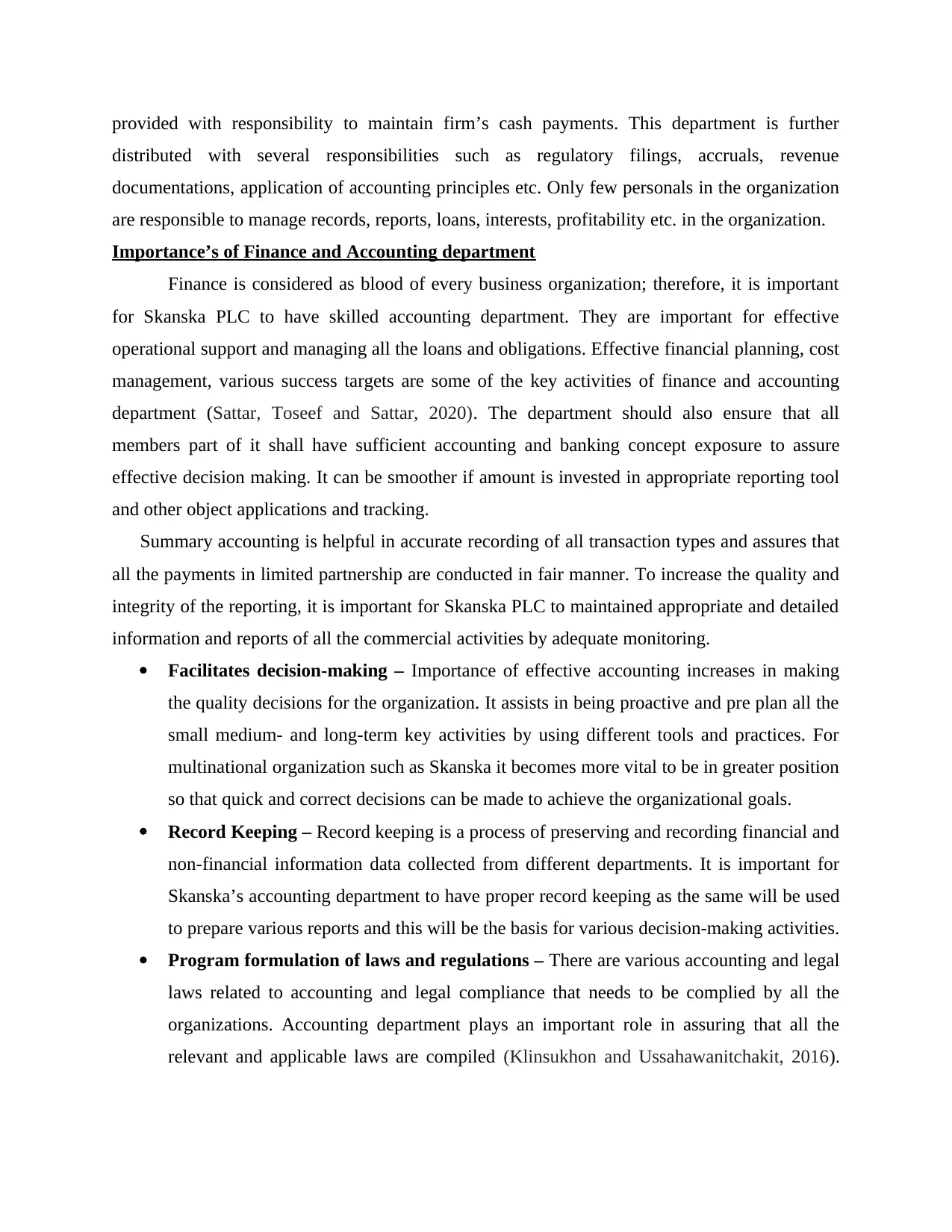
provided with responsibility to maintain firm’s cash payments. This department is further
distributed with several responsibilities such as regulatory filings, accruals, revenue
documentations, application of accounting principles etc. Only few personals in the organization
are responsible to manage records, reports, loans, interests, profitability etc. in the organization.
Importance’s of Finance and Accounting department
Finance is considered as blood of every business organization; therefore, it is important
for Skanska PLC to have skilled accounting department. They are important for effective
operational support and managing all the loans and obligations. Effective financial planning, cost
management, various success targets are some of the key activities of finance and accounting
department (Sattar, Toseef and Sattar, 2020). The department should also ensure that all
members part of it shall have sufficient accounting and banking concept exposure to assure
effective decision making. It can be smoother if amount is invested in appropriate reporting tool
and other object applications and tracking.
Summary accounting is helpful in accurate recording of all transaction types and assures that
all the payments in limited partnership are conducted in fair manner. To increase the quality and
integrity of the reporting, it is important for Skanska PLC to maintained appropriate and detailed
information and reports of all the commercial activities by adequate monitoring.
Facilitates decision-making – Importance of effective accounting increases in making
the quality decisions for the organization. It assists in being proactive and pre plan all the
small medium- and long-term key activities by using different tools and practices. For
multinational organization such as Skanska it becomes more vital to be in greater position
so that quick and correct decisions can be made to achieve the organizational goals.
Record Keeping – Record keeping is a process of preserving and recording financial and
non-financial information data collected from different departments. It is important for
Skanska’s accounting department to have proper record keeping as the same will be used
to prepare various reports and this will be the basis for various decision-making activities.
Program formulation of laws and regulations – There are various accounting and legal
laws related to accounting and legal compliance that needs to be complied by all the
organizations. Accounting department plays an important role in assuring that all the
relevant and applicable laws are compiled (Klinsukhon and Ussahawanitchakit, 2016).
distributed with several responsibilities such as regulatory filings, accruals, revenue
documentations, application of accounting principles etc. Only few personals in the organization
are responsible to manage records, reports, loans, interests, profitability etc. in the organization.
Importance’s of Finance and Accounting department
Finance is considered as blood of every business organization; therefore, it is important
for Skanska PLC to have skilled accounting department. They are important for effective
operational support and managing all the loans and obligations. Effective financial planning, cost
management, various success targets are some of the key activities of finance and accounting
department (Sattar, Toseef and Sattar, 2020). The department should also ensure that all
members part of it shall have sufficient accounting and banking concept exposure to assure
effective decision making. It can be smoother if amount is invested in appropriate reporting tool
and other object applications and tracking.
Summary accounting is helpful in accurate recording of all transaction types and assures that
all the payments in limited partnership are conducted in fair manner. To increase the quality and
integrity of the reporting, it is important for Skanska PLC to maintained appropriate and detailed
information and reports of all the commercial activities by adequate monitoring.
Facilitates decision-making – Importance of effective accounting increases in making
the quality decisions for the organization. It assists in being proactive and pre plan all the
small medium- and long-term key activities by using different tools and practices. For
multinational organization such as Skanska it becomes more vital to be in greater position
so that quick and correct decisions can be made to achieve the organizational goals.
Record Keeping – Record keeping is a process of preserving and recording financial and
non-financial information data collected from different departments. It is important for
Skanska’s accounting department to have proper record keeping as the same will be used
to prepare various reports and this will be the basis for various decision-making activities.
Program formulation of laws and regulations – There are various accounting and legal
laws related to accounting and legal compliance that needs to be complied by all the
organizations. Accounting department plays an important role in assuring that all the
relevant and applicable laws are compiled (Klinsukhon and Ussahawanitchakit, 2016).
Secure Best Marks with AI Grader
Need help grading? Try our AI Grader for instant feedback on your assignments.
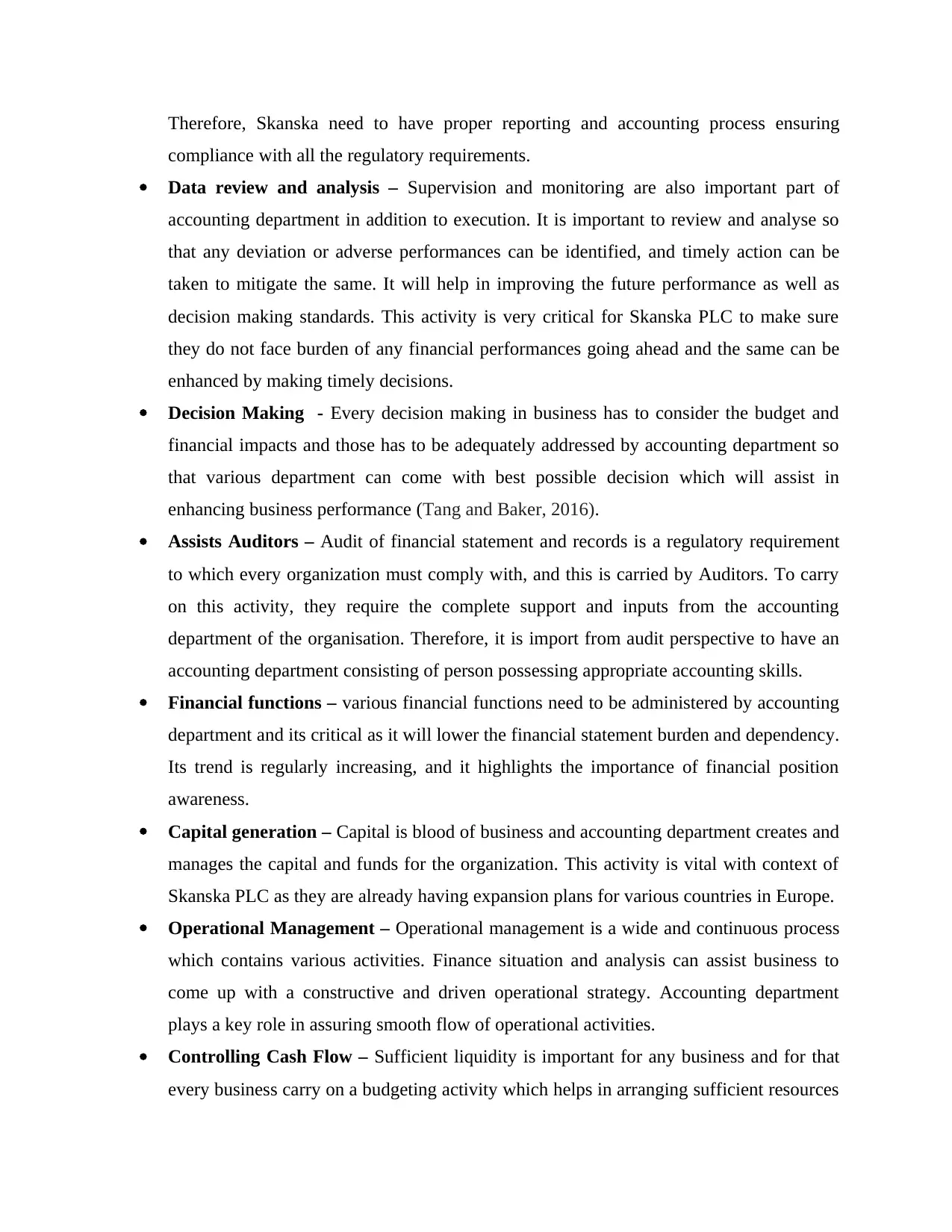
Therefore, Skanska need to have proper reporting and accounting process ensuring
compliance with all the regulatory requirements.
Data review and analysis – Supervision and monitoring are also important part of
accounting department in addition to execution. It is important to review and analyse so
that any deviation or adverse performances can be identified, and timely action can be
taken to mitigate the same. It will help in improving the future performance as well as
decision making standards. This activity is very critical for Skanska PLC to make sure
they do not face burden of any financial performances going ahead and the same can be
enhanced by making timely decisions.
Decision Making - Every decision making in business has to consider the budget and
financial impacts and those has to be adequately addressed by accounting department so
that various department can come with best possible decision which will assist in
enhancing business performance (Tang and Baker, 2016).
Assists Auditors – Audit of financial statement and records is a regulatory requirement
to which every organization must comply with, and this is carried by Auditors. To carry
on this activity, they require the complete support and inputs from the accounting
department of the organisation. Therefore, it is import from audit perspective to have an
accounting department consisting of person possessing appropriate accounting skills.
Financial functions – various financial functions need to be administered by accounting
department and its critical as it will lower the financial statement burden and dependency.
Its trend is regularly increasing, and it highlights the importance of financial position
awareness.
Capital generation – Capital is blood of business and accounting department creates and
manages the capital and funds for the organization. This activity is vital with context of
Skanska PLC as they are already having expansion plans for various countries in Europe.
Operational Management – Operational management is a wide and continuous process
which contains various activities. Finance situation and analysis can assist business to
come up with a constructive and driven operational strategy. Accounting department
plays a key role in assuring smooth flow of operational activities.
Controlling Cash Flow – Sufficient liquidity is important for any business and for that
every business carry on a budgeting activity which helps in arranging sufficient resources
compliance with all the regulatory requirements.
Data review and analysis – Supervision and monitoring are also important part of
accounting department in addition to execution. It is important to review and analyse so
that any deviation or adverse performances can be identified, and timely action can be
taken to mitigate the same. It will help in improving the future performance as well as
decision making standards. This activity is very critical for Skanska PLC to make sure
they do not face burden of any financial performances going ahead and the same can be
enhanced by making timely decisions.
Decision Making - Every decision making in business has to consider the budget and
financial impacts and those has to be adequately addressed by accounting department so
that various department can come with best possible decision which will assist in
enhancing business performance (Tang and Baker, 2016).
Assists Auditors – Audit of financial statement and records is a regulatory requirement
to which every organization must comply with, and this is carried by Auditors. To carry
on this activity, they require the complete support and inputs from the accounting
department of the organisation. Therefore, it is import from audit perspective to have an
accounting department consisting of person possessing appropriate accounting skills.
Financial functions – various financial functions need to be administered by accounting
department and its critical as it will lower the financial statement burden and dependency.
Its trend is regularly increasing, and it highlights the importance of financial position
awareness.
Capital generation – Capital is blood of business and accounting department creates and
manages the capital and funds for the organization. This activity is vital with context of
Skanska PLC as they are already having expansion plans for various countries in Europe.
Operational Management – Operational management is a wide and continuous process
which contains various activities. Finance situation and analysis can assist business to
come up with a constructive and driven operational strategy. Accounting department
plays a key role in assuring smooth flow of operational activities.
Controlling Cash Flow – Sufficient liquidity is important for any business and for that
every business carry on a budgeting activity which helps in arranging sufficient resources
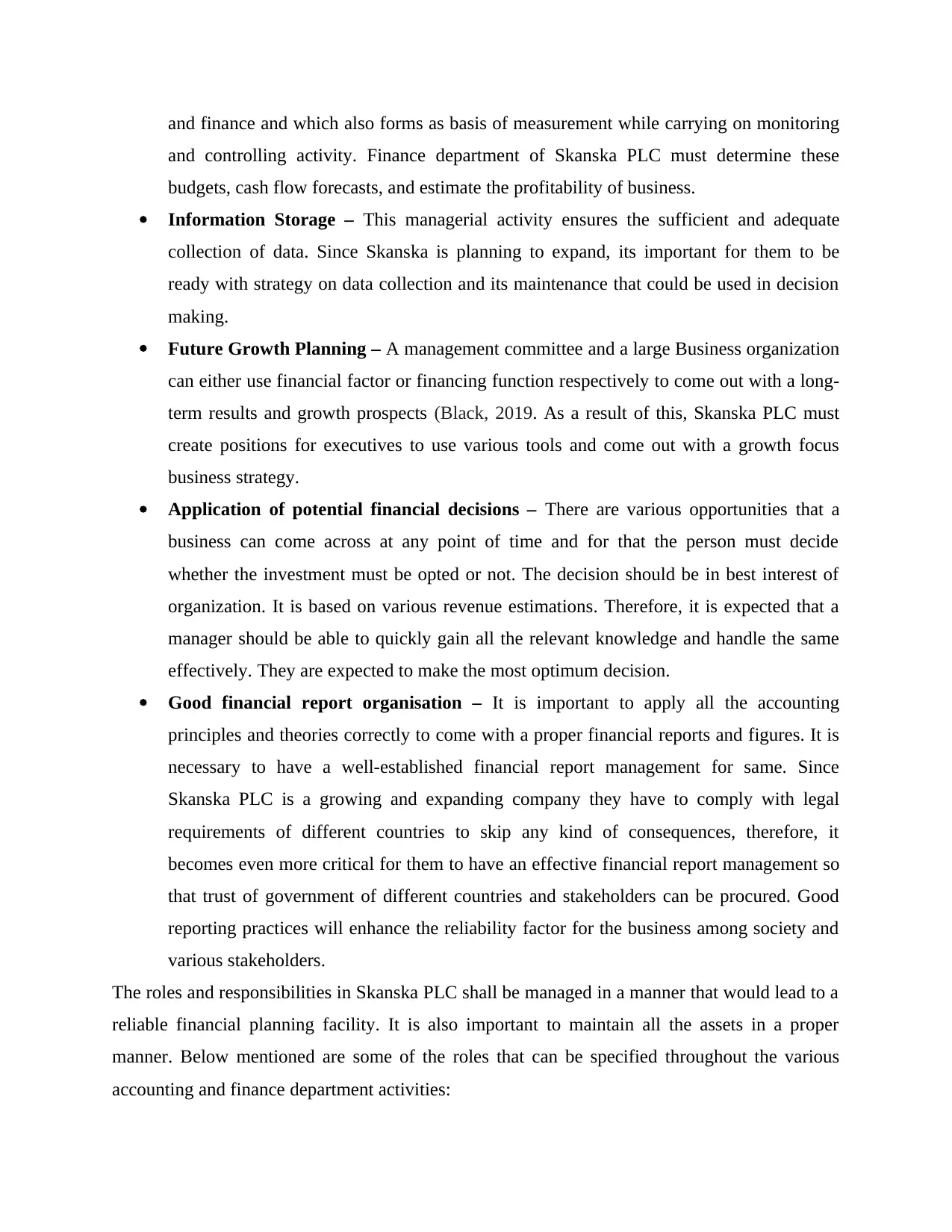
and finance and which also forms as basis of measurement while carrying on monitoring
and controlling activity. Finance department of Skanska PLC must determine these
budgets, cash flow forecasts, and estimate the profitability of business.
Information Storage – This managerial activity ensures the sufficient and adequate
collection of data. Since Skanska is planning to expand, its important for them to be
ready with strategy on data collection and its maintenance that could be used in decision
making.
Future Growth Planning – A management committee and a large Business organization
can either use financial factor or financing function respectively to come out with a long-
term results and growth prospects (Black, 2019. As a result of this, Skanska PLC must
create positions for executives to use various tools and come out with a growth focus
business strategy.
Application of potential financial decisions – There are various opportunities that a
business can come across at any point of time and for that the person must decide
whether the investment must be opted or not. The decision should be in best interest of
organization. It is based on various revenue estimations. Therefore, it is expected that a
manager should be able to quickly gain all the relevant knowledge and handle the same
effectively. They are expected to make the most optimum decision.
Good financial report organisation – It is important to apply all the accounting
principles and theories correctly to come with a proper financial reports and figures. It is
necessary to have a well-established financial report management for same. Since
Skanska PLC is a growing and expanding company they have to comply with legal
requirements of different countries to skip any kind of consequences, therefore, it
becomes even more critical for them to have an effective financial report management so
that trust of government of different countries and stakeholders can be procured. Good
reporting practices will enhance the reliability factor for the business among society and
various stakeholders.
The roles and responsibilities in Skanska PLC shall be managed in a manner that would lead to a
reliable financial planning facility. It is also important to maintain all the assets in a proper
manner. Below mentioned are some of the roles that can be specified throughout the various
accounting and finance department activities:
and controlling activity. Finance department of Skanska PLC must determine these
budgets, cash flow forecasts, and estimate the profitability of business.
Information Storage – This managerial activity ensures the sufficient and adequate
collection of data. Since Skanska is planning to expand, its important for them to be
ready with strategy on data collection and its maintenance that could be used in decision
making.
Future Growth Planning – A management committee and a large Business organization
can either use financial factor or financing function respectively to come out with a long-
term results and growth prospects (Black, 2019. As a result of this, Skanska PLC must
create positions for executives to use various tools and come out with a growth focus
business strategy.
Application of potential financial decisions – There are various opportunities that a
business can come across at any point of time and for that the person must decide
whether the investment must be opted or not. The decision should be in best interest of
organization. It is based on various revenue estimations. Therefore, it is expected that a
manager should be able to quickly gain all the relevant knowledge and handle the same
effectively. They are expected to make the most optimum decision.
Good financial report organisation – It is important to apply all the accounting
principles and theories correctly to come with a proper financial reports and figures. It is
necessary to have a well-established financial report management for same. Since
Skanska PLC is a growing and expanding company they have to comply with legal
requirements of different countries to skip any kind of consequences, therefore, it
becomes even more critical for them to have an effective financial report management so
that trust of government of different countries and stakeholders can be procured. Good
reporting practices will enhance the reliability factor for the business among society and
various stakeholders.
The roles and responsibilities in Skanska PLC shall be managed in a manner that would lead to a
reliable financial planning facility. It is also important to maintain all the assets in a proper
manner. Below mentioned are some of the roles that can be specified throughout the various
accounting and finance department activities:
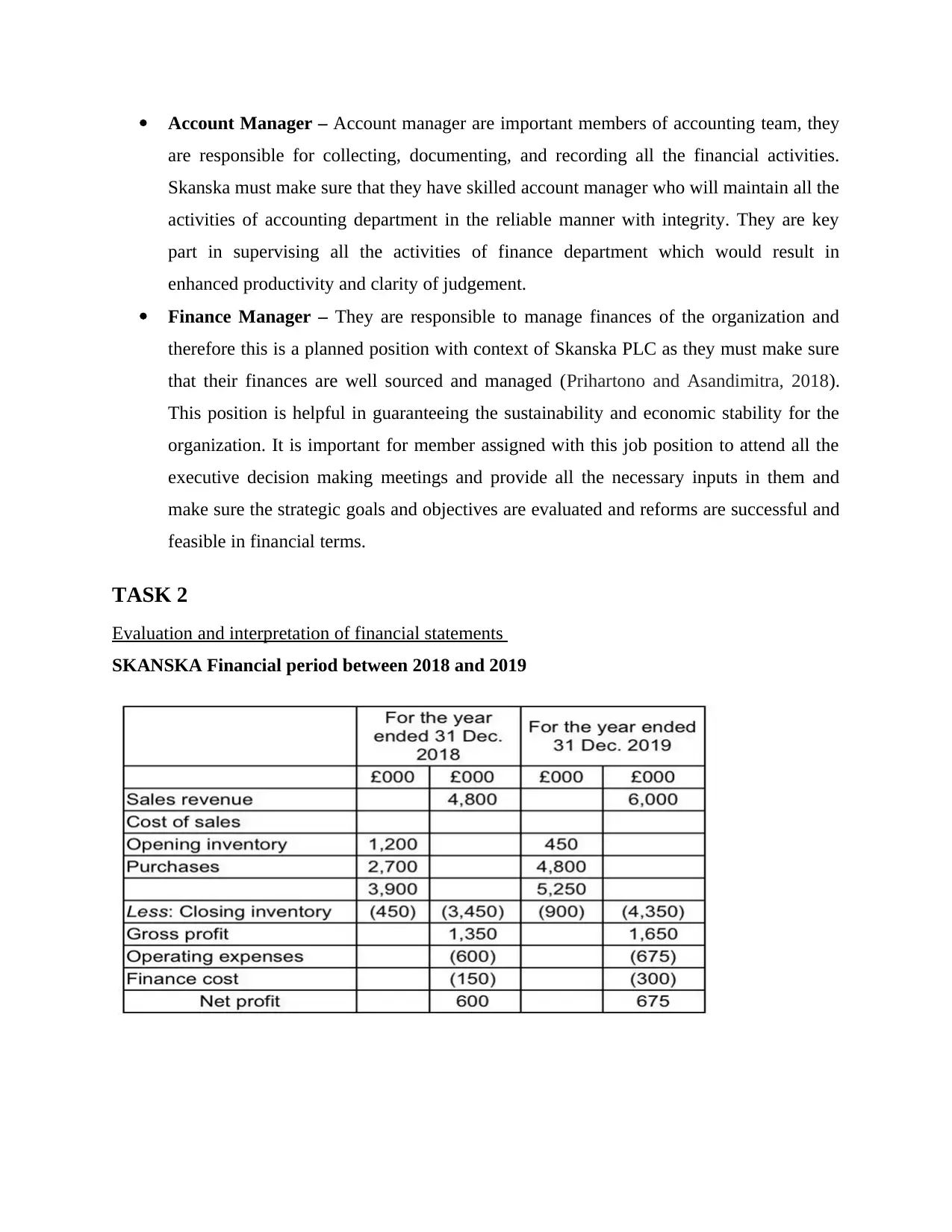
Account Manager – Account manager are important members of accounting team, they
are responsible for collecting, documenting, and recording all the financial activities.
Skanska must make sure that they have skilled account manager who will maintain all the
activities of accounting department in the reliable manner with integrity. They are key
part in supervising all the activities of finance department which would result in
enhanced productivity and clarity of judgement.
Finance Manager – They are responsible to manage finances of the organization and
therefore this is a planned position with context of Skanska PLC as they must make sure
that their finances are well sourced and managed (Prihartono and Asandimitra, 2018).
This position is helpful in guaranteeing the sustainability and economic stability for the
organization. It is important for member assigned with this job position to attend all the
executive decision making meetings and provide all the necessary inputs in them and
make sure the strategic goals and objectives are evaluated and reforms are successful and
feasible in financial terms.
TASK 2
Evaluation and interpretation of financial statements
SKANSKA Financial period between 2018 and 2019
are responsible for collecting, documenting, and recording all the financial activities.
Skanska must make sure that they have skilled account manager who will maintain all the
activities of accounting department in the reliable manner with integrity. They are key
part in supervising all the activities of finance department which would result in
enhanced productivity and clarity of judgement.
Finance Manager – They are responsible to manage finances of the organization and
therefore this is a planned position with context of Skanska PLC as they must make sure
that their finances are well sourced and managed (Prihartono and Asandimitra, 2018).
This position is helpful in guaranteeing the sustainability and economic stability for the
organization. It is important for member assigned with this job position to attend all the
executive decision making meetings and provide all the necessary inputs in them and
make sure the strategic goals and objectives are evaluated and reforms are successful and
feasible in financial terms.
TASK 2
Evaluation and interpretation of financial statements
SKANSKA Financial period between 2018 and 2019
Paraphrase This Document
Need a fresh take? Get an instant paraphrase of this document with our AI Paraphraser
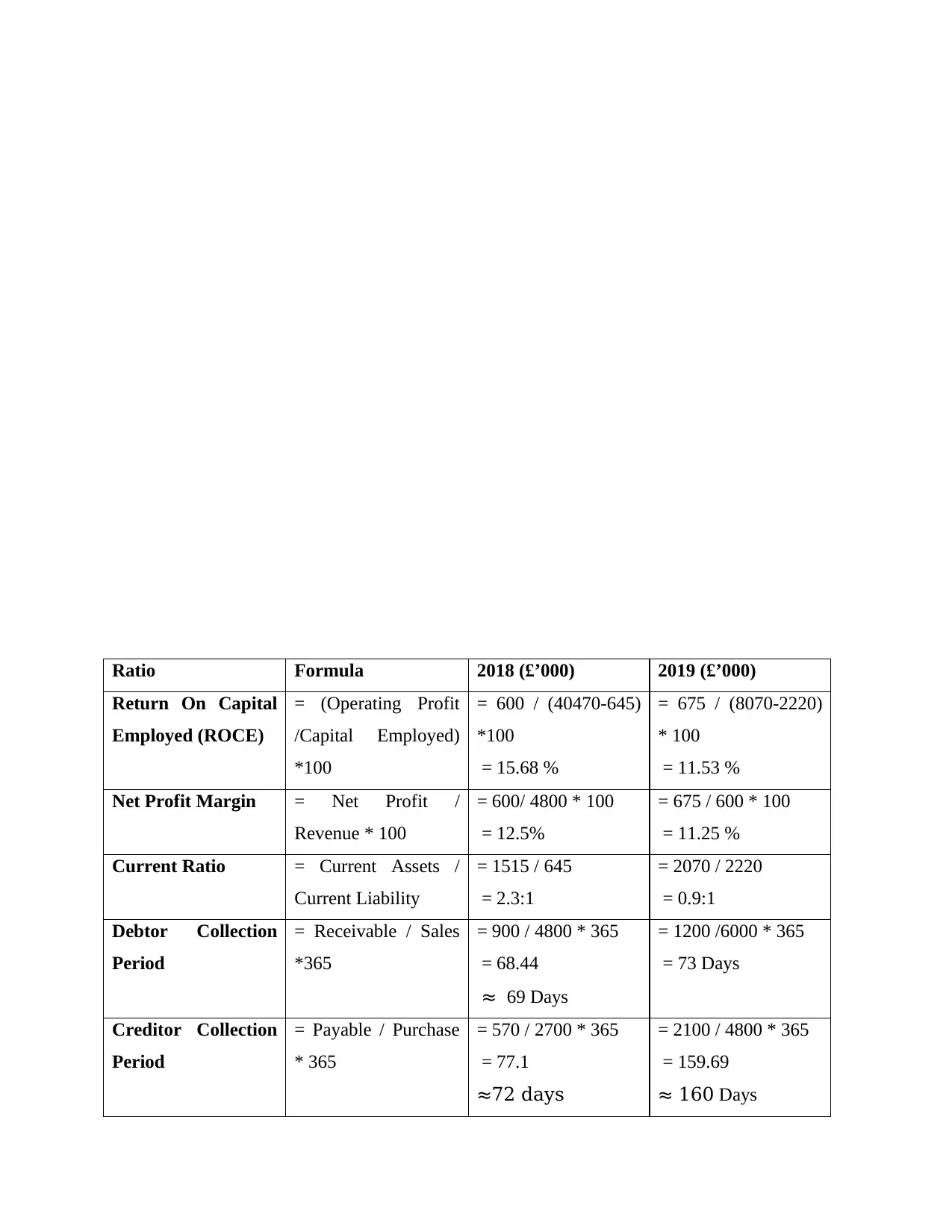
Ratio Formula 2018 (£’000) 2019 (£’000)
Return On Capital
Employed (ROCE)
= (Operating Profit
/Capital Employed)
*100
= 600 / (40470-645)
*100
= 15.68 %
= 675 / (8070-2220)
* 100
= 11.53 %
Net Profit Margin = Net Profit /
Revenue * 100
= 600/ 4800 * 100
= 12.5%
= 675 / 600 * 100
= 11.25 %
Current Ratio = Current Assets /
Current Liability
= 1515 / 645
= 2.3:1
= 2070 / 2220
= 0.9:1
Debtor Collection
Period
= Receivable / Sales
*365
= 900 / 4800 * 365
= 68.44
≈ 69 Days
= 1200 /6000 * 365
= 73 Days
Creditor Collection
Period
= Payable / Purchase
* 365
= 570 / 2700 * 365
= 77.1
≈72 days
= 2100 / 4800 * 365
= 159.69
≈ 160 Days
Return On Capital
Employed (ROCE)
= (Operating Profit
/Capital Employed)
*100
= 600 / (40470-645)
*100
= 15.68 %
= 675 / (8070-2220)
* 100
= 11.53 %
Net Profit Margin = Net Profit /
Revenue * 100
= 600/ 4800 * 100
= 12.5%
= 675 / 600 * 100
= 11.25 %
Current Ratio = Current Assets /
Current Liability
= 1515 / 645
= 2.3:1
= 2070 / 2220
= 0.9:1
Debtor Collection
Period
= Receivable / Sales
*365
= 900 / 4800 * 365
= 68.44
≈ 69 Days
= 1200 /6000 * 365
= 73 Days
Creditor Collection
Period
= Payable / Purchase
* 365
= 570 / 2700 * 365
= 77.1
≈72 days
= 2100 / 4800 * 365
= 159.69
≈ 160 Days
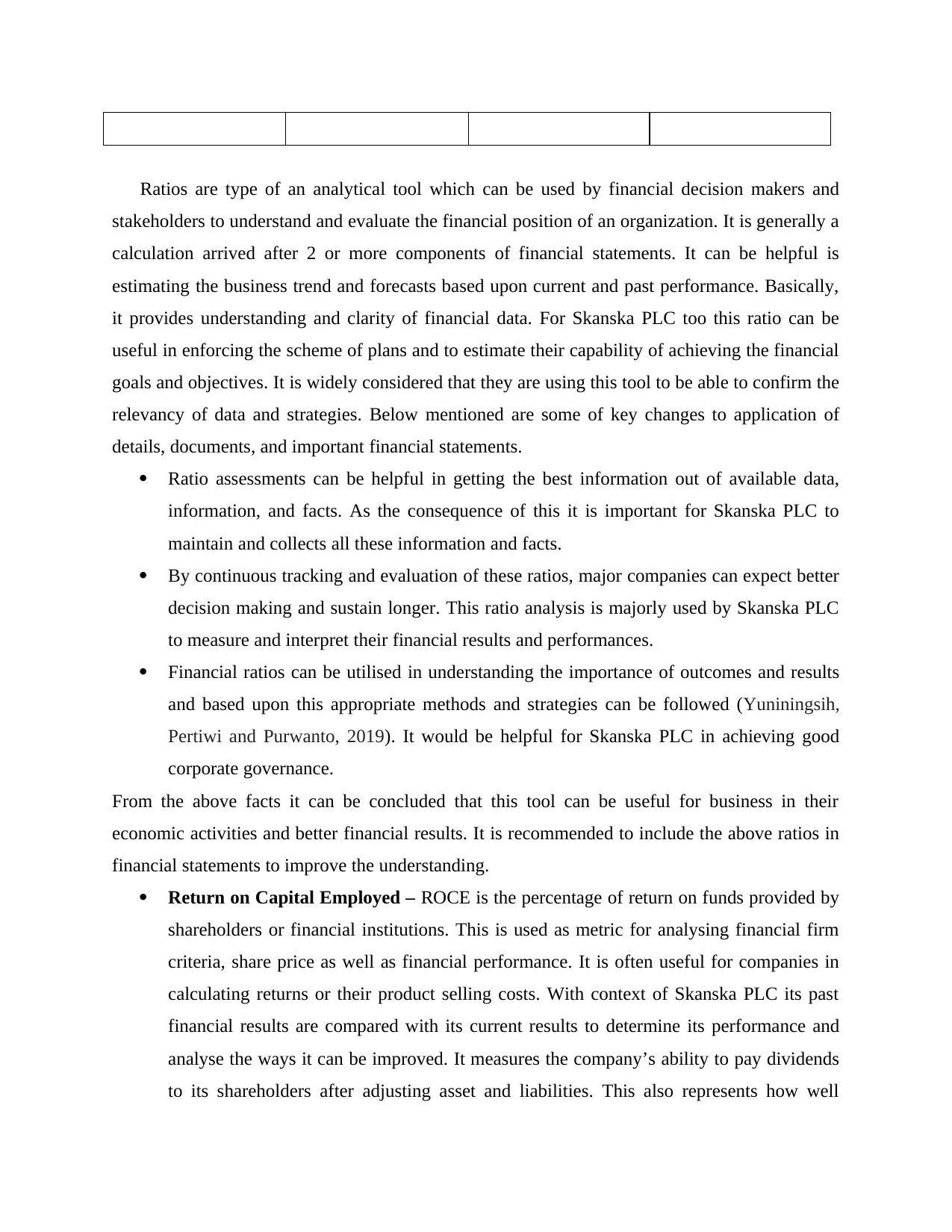
Ratios are type of an analytical tool which can be used by financial decision makers and
stakeholders to understand and evaluate the financial position of an organization. It is generally a
calculation arrived after 2 or more components of financial statements. It can be helpful is
estimating the business trend and forecasts based upon current and past performance. Basically,
it provides understanding and clarity of financial data. For Skanska PLC too this ratio can be
useful in enforcing the scheme of plans and to estimate their capability of achieving the financial
goals and objectives. It is widely considered that they are using this tool to be able to confirm the
relevancy of data and strategies. Below mentioned are some of key changes to application of
details, documents, and important financial statements.
Ratio assessments can be helpful in getting the best information out of available data,
information, and facts. As the consequence of this it is important for Skanska PLC to
maintain and collects all these information and facts.
By continuous tracking and evaluation of these ratios, major companies can expect better
decision making and sustain longer. This ratio analysis is majorly used by Skanska PLC
to measure and interpret their financial results and performances.
Financial ratios can be utilised in understanding the importance of outcomes and results
and based upon this appropriate methods and strategies can be followed (Yuniningsih,
Pertiwi and Purwanto, 2019). It would be helpful for Skanska PLC in achieving good
corporate governance.
From the above facts it can be concluded that this tool can be useful for business in their
economic activities and better financial results. It is recommended to include the above ratios in
financial statements to improve the understanding.
Return on Capital Employed – ROCE is the percentage of return on funds provided by
shareholders or financial institutions. This is used as metric for analysing financial firm
criteria, share price as well as financial performance. It is often useful for companies in
calculating returns or their product selling costs. With context of Skanska PLC its past
financial results are compared with its current results to determine its performance and
analyse the ways it can be improved. It measures the company’s ability to pay dividends
to its shareholders after adjusting asset and liabilities. This also represents how well
stakeholders to understand and evaluate the financial position of an organization. It is generally a
calculation arrived after 2 or more components of financial statements. It can be helpful is
estimating the business trend and forecasts based upon current and past performance. Basically,
it provides understanding and clarity of financial data. For Skanska PLC too this ratio can be
useful in enforcing the scheme of plans and to estimate their capability of achieving the financial
goals and objectives. It is widely considered that they are using this tool to be able to confirm the
relevancy of data and strategies. Below mentioned are some of key changes to application of
details, documents, and important financial statements.
Ratio assessments can be helpful in getting the best information out of available data,
information, and facts. As the consequence of this it is important for Skanska PLC to
maintain and collects all these information and facts.
By continuous tracking and evaluation of these ratios, major companies can expect better
decision making and sustain longer. This ratio analysis is majorly used by Skanska PLC
to measure and interpret their financial results and performances.
Financial ratios can be utilised in understanding the importance of outcomes and results
and based upon this appropriate methods and strategies can be followed (Yuniningsih,
Pertiwi and Purwanto, 2019). It would be helpful for Skanska PLC in achieving good
corporate governance.
From the above facts it can be concluded that this tool can be useful for business in their
economic activities and better financial results. It is recommended to include the above ratios in
financial statements to improve the understanding.
Return on Capital Employed – ROCE is the percentage of return on funds provided by
shareholders or financial institutions. This is used as metric for analysing financial firm
criteria, share price as well as financial performance. It is often useful for companies in
calculating returns or their product selling costs. With context of Skanska PLC its past
financial results are compared with its current results to determine its performance and
analyse the ways it can be improved. It measures the company’s ability to pay dividends
to its shareholders after adjusting asset and liabilities. This also represents how well
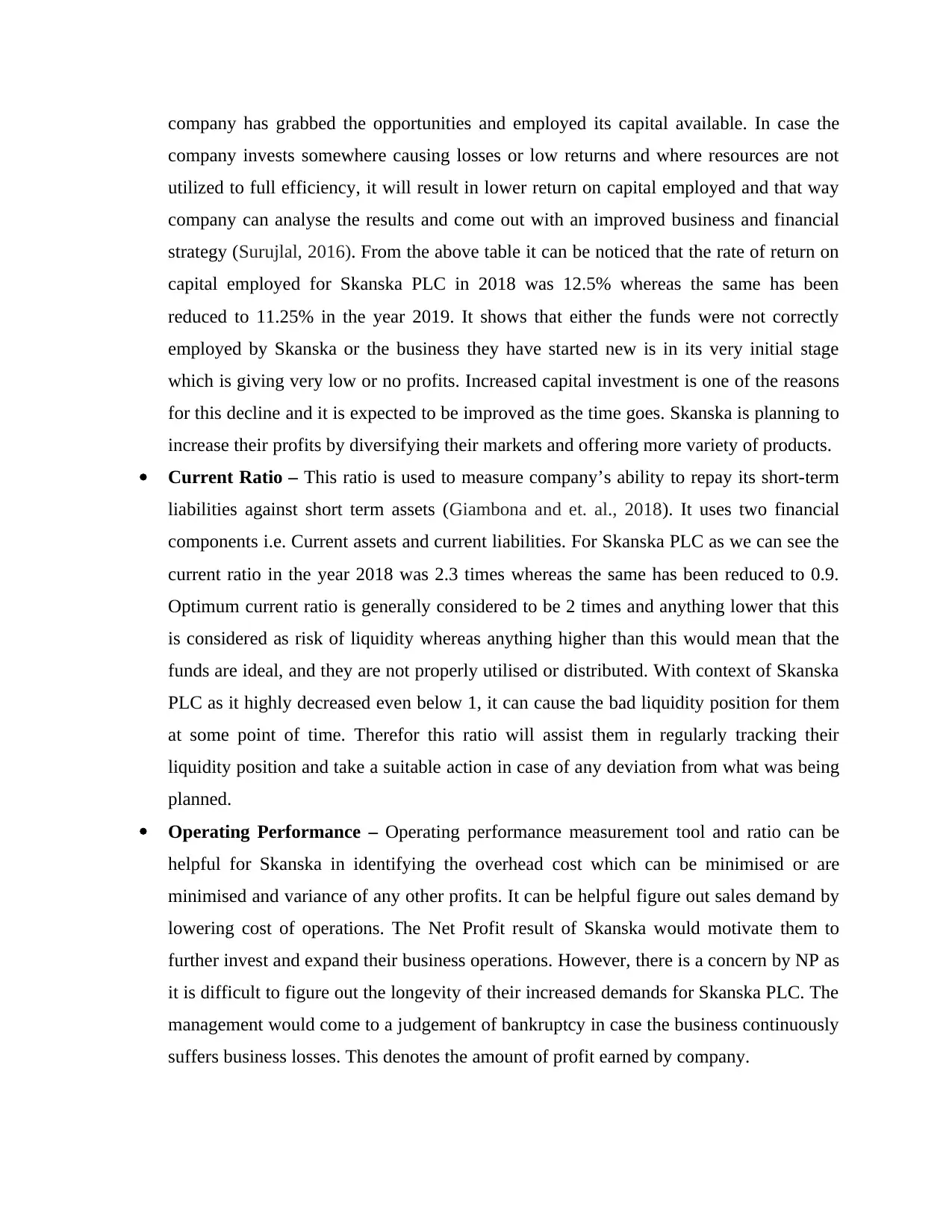
company has grabbed the opportunities and employed its capital available. In case the
company invests somewhere causing losses or low returns and where resources are not
utilized to full efficiency, it will result in lower return on capital employed and that way
company can analyse the results and come out with an improved business and financial
strategy (Surujlal, 2016). From the above table it can be noticed that the rate of return on
capital employed for Skanska PLC in 2018 was 12.5% whereas the same has been
reduced to 11.25% in the year 2019. It shows that either the funds were not correctly
employed by Skanska or the business they have started new is in its very initial stage
which is giving very low or no profits. Increased capital investment is one of the reasons
for this decline and it is expected to be improved as the time goes. Skanska is planning to
increase their profits by diversifying their markets and offering more variety of products.
Current Ratio – This ratio is used to measure company’s ability to repay its short-term
liabilities against short term assets (Giambona and et. al., 2018). It uses two financial
components i.e. Current assets and current liabilities. For Skanska PLC as we can see the
current ratio in the year 2018 was 2.3 times whereas the same has been reduced to 0.9.
Optimum current ratio is generally considered to be 2 times and anything lower that this
is considered as risk of liquidity whereas anything higher than this would mean that the
funds are ideal, and they are not properly utilised or distributed. With context of Skanska
PLC as it highly decreased even below 1, it can cause the bad liquidity position for them
at some point of time. Therefor this ratio will assist them in regularly tracking their
liquidity position and take a suitable action in case of any deviation from what was being
planned.
Operating Performance – Operating performance measurement tool and ratio can be
helpful for Skanska in identifying the overhead cost which can be minimised or are
minimised and variance of any other profits. It can be helpful figure out sales demand by
lowering cost of operations. The Net Profit result of Skanska would motivate them to
further invest and expand their business operations. However, there is a concern by NP as
it is difficult to figure out the longevity of their increased demands for Skanska PLC. The
management would come to a judgement of bankruptcy in case the business continuously
suffers business losses. This denotes the amount of profit earned by company.
company invests somewhere causing losses or low returns and where resources are not
utilized to full efficiency, it will result in lower return on capital employed and that way
company can analyse the results and come out with an improved business and financial
strategy (Surujlal, 2016). From the above table it can be noticed that the rate of return on
capital employed for Skanska PLC in 2018 was 12.5% whereas the same has been
reduced to 11.25% in the year 2019. It shows that either the funds were not correctly
employed by Skanska or the business they have started new is in its very initial stage
which is giving very low or no profits. Increased capital investment is one of the reasons
for this decline and it is expected to be improved as the time goes. Skanska is planning to
increase their profits by diversifying their markets and offering more variety of products.
Current Ratio – This ratio is used to measure company’s ability to repay its short-term
liabilities against short term assets (Giambona and et. al., 2018). It uses two financial
components i.e. Current assets and current liabilities. For Skanska PLC as we can see the
current ratio in the year 2018 was 2.3 times whereas the same has been reduced to 0.9.
Optimum current ratio is generally considered to be 2 times and anything lower that this
is considered as risk of liquidity whereas anything higher than this would mean that the
funds are ideal, and they are not properly utilised or distributed. With context of Skanska
PLC as it highly decreased even below 1, it can cause the bad liquidity position for them
at some point of time. Therefor this ratio will assist them in regularly tracking their
liquidity position and take a suitable action in case of any deviation from what was being
planned.
Operating Performance – Operating performance measurement tool and ratio can be
helpful for Skanska in identifying the overhead cost which can be minimised or are
minimised and variance of any other profits. It can be helpful figure out sales demand by
lowering cost of operations. The Net Profit result of Skanska would motivate them to
further invest and expand their business operations. However, there is a concern by NP as
it is difficult to figure out the longevity of their increased demands for Skanska PLC. The
management would come to a judgement of bankruptcy in case the business continuously
suffers business losses. This denotes the amount of profit earned by company.
Secure Best Marks with AI Grader
Need help grading? Try our AI Grader for instant feedback on your assignments.
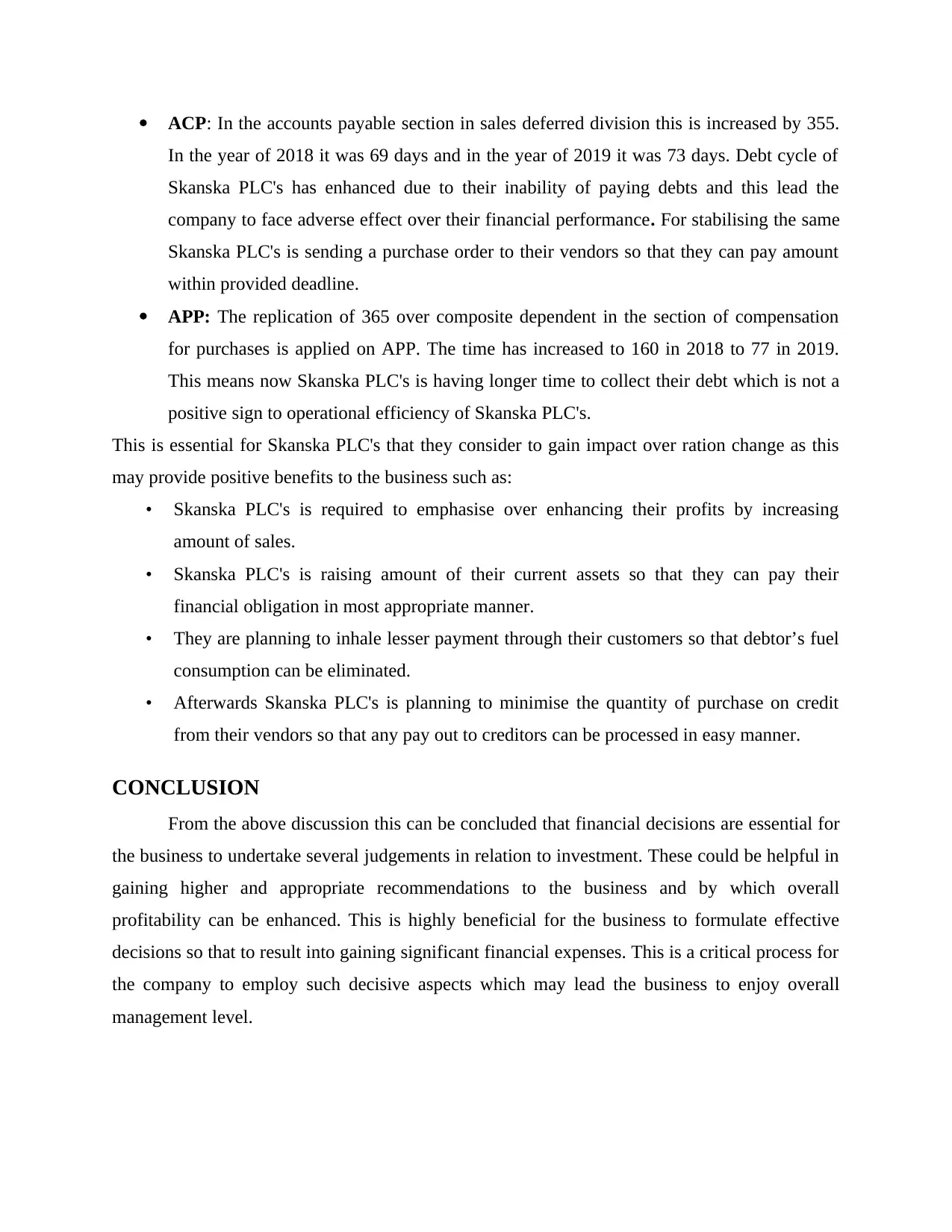
ACP: In the accounts payable section in sales deferred division this is increased by 355.
In the year of 2018 it was 69 days and in the year of 2019 it was 73 days. Debt cycle of
Skanska PLC's has enhanced due to their inability of paying debts and this lead the
company to face adverse effect over their financial performance. For stabilising the same
Skanska PLC's is sending a purchase order to their vendors so that they can pay amount
within provided deadline.
APP: The replication of 365 over composite dependent in the section of compensation
for purchases is applied on APP. The time has increased to 160 in 2018 to 77 in 2019.
This means now Skanska PLC's is having longer time to collect their debt which is not a
positive sign to operational efficiency of Skanska PLC's.
This is essential for Skanska PLC's that they consider to gain impact over ration change as this
may provide positive benefits to the business such as:
• Skanska PLC's is required to emphasise over enhancing their profits by increasing
amount of sales.
• Skanska PLC's is raising amount of their current assets so that they can pay their
financial obligation in most appropriate manner.
• They are planning to inhale lesser payment through their customers so that debtor’s fuel
consumption can be eliminated.
• Afterwards Skanska PLC's is planning to minimise the quantity of purchase on credit
from their vendors so that any pay out to creditors can be processed in easy manner.
CONCLUSION
From the above discussion this can be concluded that financial decisions are essential for
the business to undertake several judgements in relation to investment. These could be helpful in
gaining higher and appropriate recommendations to the business and by which overall
profitability can be enhanced. This is highly beneficial for the business to formulate effective
decisions so that to result into gaining significant financial expenses. This is a critical process for
the company to employ such decisive aspects which may lead the business to enjoy overall
management level.
In the year of 2018 it was 69 days and in the year of 2019 it was 73 days. Debt cycle of
Skanska PLC's has enhanced due to their inability of paying debts and this lead the
company to face adverse effect over their financial performance. For stabilising the same
Skanska PLC's is sending a purchase order to their vendors so that they can pay amount
within provided deadline.
APP: The replication of 365 over composite dependent in the section of compensation
for purchases is applied on APP. The time has increased to 160 in 2018 to 77 in 2019.
This means now Skanska PLC's is having longer time to collect their debt which is not a
positive sign to operational efficiency of Skanska PLC's.
This is essential for Skanska PLC's that they consider to gain impact over ration change as this
may provide positive benefits to the business such as:
• Skanska PLC's is required to emphasise over enhancing their profits by increasing
amount of sales.
• Skanska PLC's is raising amount of their current assets so that they can pay their
financial obligation in most appropriate manner.
• They are planning to inhale lesser payment through their customers so that debtor’s fuel
consumption can be eliminated.
• Afterwards Skanska PLC's is planning to minimise the quantity of purchase on credit
from their vendors so that any pay out to creditors can be processed in easy manner.
CONCLUSION
From the above discussion this can be concluded that financial decisions are essential for
the business to undertake several judgements in relation to investment. These could be helpful in
gaining higher and appropriate recommendations to the business and by which overall
profitability can be enhanced. This is highly beneficial for the business to formulate effective
decisions so that to result into gaining significant financial expenses. This is a critical process for
the company to employ such decisive aspects which may lead the business to enjoy overall
management level.
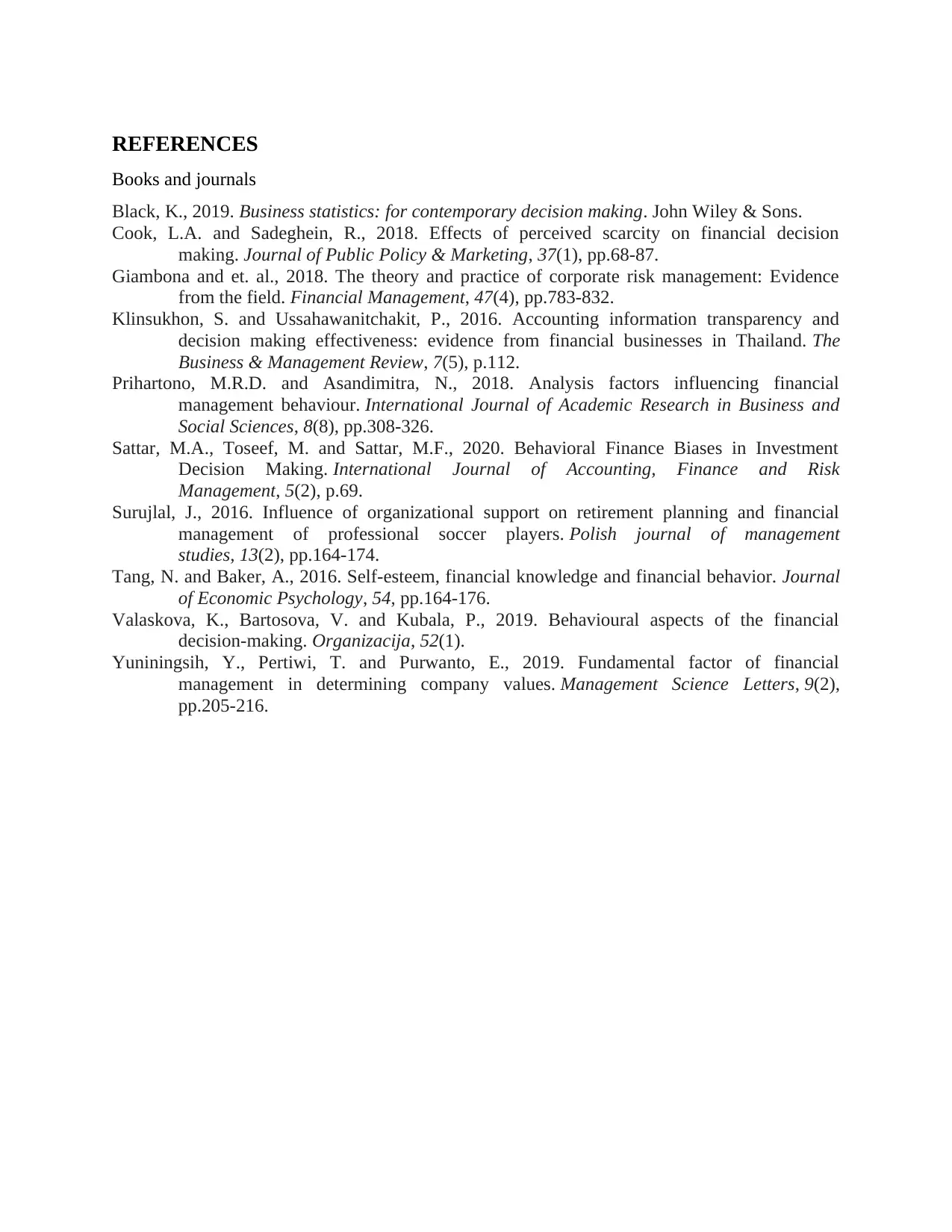
REFERENCES
Books and journals
Black, K., 2019. Business statistics: for contemporary decision making. John Wiley & Sons.
Cook, L.A. and Sadeghein, R., 2018. Effects of perceived scarcity on financial decision
making. Journal of Public Policy & Marketing, 37(1), pp.68-87.
Giambona and et. al., 2018. The theory and practice of corporate risk management: Evidence
from the field. Financial Management, 47(4), pp.783-832.
Klinsukhon, S. and Ussahawanitchakit, P., 2016. Accounting information transparency and
decision making effectiveness: evidence from financial businesses in Thailand. The
Business & Management Review, 7(5), p.112.
Prihartono, M.R.D. and Asandimitra, N., 2018. Analysis factors influencing financial
management behaviour. International Journal of Academic Research in Business and
Social Sciences, 8(8), pp.308-326.
Sattar, M.A., Toseef, M. and Sattar, M.F., 2020. Behavioral Finance Biases in Investment
Decision Making. International Journal of Accounting, Finance and Risk
Management, 5(2), p.69.
Surujlal, J., 2016. Influence of organizational support on retirement planning and financial
management of professional soccer players. Polish journal of management
studies, 13(2), pp.164-174.
Tang, N. and Baker, A., 2016. Self-esteem, financial knowledge and financial behavior. Journal
of Economic Psychology, 54, pp.164-176.
Valaskova, K., Bartosova, V. and Kubala, P., 2019. Behavioural aspects of the financial
decision-making. Organizacija, 52(1).
Yuniningsih, Y., Pertiwi, T. and Purwanto, E., 2019. Fundamental factor of financial
management in determining company values. Management Science Letters, 9(2),
pp.205-216.
Books and journals
Black, K., 2019. Business statistics: for contemporary decision making. John Wiley & Sons.
Cook, L.A. and Sadeghein, R., 2018. Effects of perceived scarcity on financial decision
making. Journal of Public Policy & Marketing, 37(1), pp.68-87.
Giambona and et. al., 2018. The theory and practice of corporate risk management: Evidence
from the field. Financial Management, 47(4), pp.783-832.
Klinsukhon, S. and Ussahawanitchakit, P., 2016. Accounting information transparency and
decision making effectiveness: evidence from financial businesses in Thailand. The
Business & Management Review, 7(5), p.112.
Prihartono, M.R.D. and Asandimitra, N., 2018. Analysis factors influencing financial
management behaviour. International Journal of Academic Research in Business and
Social Sciences, 8(8), pp.308-326.
Sattar, M.A., Toseef, M. and Sattar, M.F., 2020. Behavioral Finance Biases in Investment
Decision Making. International Journal of Accounting, Finance and Risk
Management, 5(2), p.69.
Surujlal, J., 2016. Influence of organizational support on retirement planning and financial
management of professional soccer players. Polish journal of management
studies, 13(2), pp.164-174.
Tang, N. and Baker, A., 2016. Self-esteem, financial knowledge and financial behavior. Journal
of Economic Psychology, 54, pp.164-176.
Valaskova, K., Bartosova, V. and Kubala, P., 2019. Behavioural aspects of the financial
decision-making. Organizacija, 52(1).
Yuniningsih, Y., Pertiwi, T. and Purwanto, E., 2019. Fundamental factor of financial
management in determining company values. Management Science Letters, 9(2),
pp.205-216.
1 out of 12
Related Documents
Your All-in-One AI-Powered Toolkit for Academic Success.
+13062052269
info@desklib.com
Available 24*7 on WhatsApp / Email
![[object Object]](/_next/static/media/star-bottom.7253800d.svg)
Unlock your academic potential
© 2024 | Zucol Services PVT LTD | All rights reserved.





